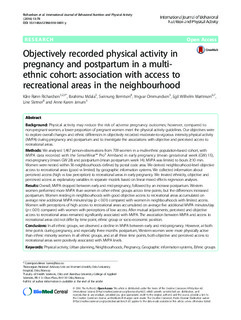| dc.description.abstract | Background: Physical activity may reduce the risk of adverse pregnancy outcomes; however, compared to non-pregnant women, a lower proportion of pregnant women meet the physical activity guidelines. Our objectives were to explore overall changes and ethnic differences in objectively recorded moderate-to-vigorous intensity physical activity (MVPA) during pregnancy and postpartum and to investigate the associations with objective and perceived access to recreational areas. Methods: We analysed 1,467 person-observations from 709 women in a multi-ethnic population-based cohort, with MVPA data recorded with the SenseWear™ Pro3 Armband in early pregnancy (mean gestational week (GW) 15), mid-pregnancy (mean GW 28) and postpartum (mean postpartum week 14). MVPA was limited to bouts ≥10 min. Women were nested within 56 neighbourhoods defined by postal code area. We derived neighbourhood-level objective access to recreational areas (good vs limited) by geographic information systems. We collected information about perceived access (high vs low perception) to recreational areas in early pregnancy. We treated ethnicity, objective and perceived access as explanatory variables in separate models based on linear mixed effects regression analyses. Results: Overall, MVPA dropped between early and mid-pregnancy, followed by an increase postpartum. Western women performed more MVPA than women in other ethnic groups across time points, but the differences increased postpartum. Women residing in neighbourhoods with good objective access to recreational areas accumulated on average nine additional MVPA minutes/day (p < 0.01) compared with women in neighbourhoods with limited access. Women with perceptions of high access to recreational areas accumulated on average five additional MVPA minutes/day (p < 0.01) compared with women with perceptions of low access. After mutual adjustments, perceived and objective access to recreational areas remained significantly associated with MVPA. The association between MVPA and access to recreational areas did not differ by time point, ethnic group or socio-economic position. Conclusions: In all ethnic groups, we observed a decline in MVPA between early and mid-pregnancy. However, at both time points during pregnancy, and especially three months postpartum, Western women were more physically active than ethnic minority women. In all ethnic groups, and at all three time points, both objective and perceived access to recreational areas were positively associated with MVPA levels. | |
